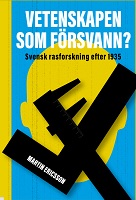Vetenskapen som försvann?
Svensk rasforskning efter 1935
| dc.contributor.author | Ericsson, Martin | |
| dc.date.accessioned | 2023-10-23T11:51:02Z | |
| dc.date.available | 2023-10-23T11:51:02Z | |
| dc.date.issued | 2023 | |
| dc.identifier | OCN: 1406069489 | |
| dc.identifier.uri | https://library.oapen.org/handle/20.500.12657/77005 | |
| dc.description.abstract | It is well known that Sweden once had a state institute for racial biology, as well as that extensive racial research was conducted in Sweden during the first decades of the 20th century. But what actually happened to Swedish race research after the 1930s - did it just disappear? In The science that disappeared? historian Martin Ericsson conducts the first systematic survey of Swedish race research from the mid-1930s to the early 1970s. It is a story of a racial science that survived the horrors of World War II and endured longer than we might like to believe as criticism grew in the post-war period. And about the Norwegian Institute for Racial Biology, which was never shut down, but lived on in a different form and under a different name. Ericsson shows that there was not a single Swedish racial research tradition, but two. One was based on the first director of the Institute of Racial Biology, Herman Lundborg, and had clear connections to Nazism and other extreme right-wing movements. The second can be said to be based on Lundborg's successor Gunnar Dahlberg and was instead anti-Nazi and in some cases even anti-racist. But both traditions agreed that there were different human races and that it made sense to try to measure differences between them. By following the Swedish race research until the end of the 20th century, the book also raises important questions about our own time and its interest in ""origin"" and ""descent"". How fundamentally different are today's dna analyzes from the old racial research traditions? What if we risk asking the same questions as 1930s racial biology stuck with new techniques? | en_US |
| dc.language | Swedish | en_US |
| dc.subject.other | Gunnar Dahlberg; Herman Lundborg; genetics; physical anthropology; anti-racism; scientific racism | en_US |
| dc.title | Vetenskapen som försvann? | en_US |
| dc.title.alternative | Svensk rasforskning efter 1935 | en_US |
| dc.type | book | |
| oapen.identifier.doi | 10.13068/kriterium.41 | en_US |
| oapen.relation.isPublishedBy | 7b034f4a-b816-4718-88ac-63b24c8e4b24 | en_US |
| oapen.relation.isFundedBy | adab50b0-249a-471f-b7fd-e01f2bde8172 | en_US |
| oapen.relation.isFundedBy | 703a7dbe-f101-4e91-9fc2-e906a0b70c86 | en_US |
| oapen.relation.isFundedBy | 535887a6-e2a7-46da-a929-8772866a36a6 | en_US |
| oapen.relation.isbn | 9789179243760 | en_US |
| oapen.pages | 316 | en_US |
| oapen.place.publication | Lund | en_US |
| oapen.remark.public | Funder name: Stiftelsen Karl Staaffs fond för frisinnade ändamål, Stiftelsen Konung Gustaf VI Adolfs fond för svensk kultur |

